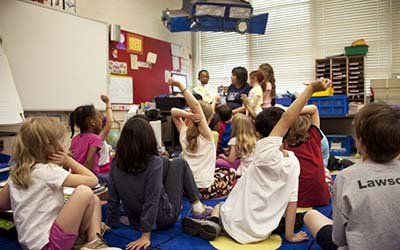As an early childhood educator, I’ve learned that young learners thrive when lessons feel like play. One of the most powerful tools I use in my classroom is storytelling—a creative method that brings math, literacy, science, and emotional development to life in a way that feels both relatable and exciting.
Incorporating storytelling into early childhood education not only makes abstract concepts easier to understand, but it also ignites imagination, turning learning into a joyful experience rather than just another task.
Teaching Addition Through Storytelling and Play
One of my favorite and most effective teaching moments happened when I introduced addition to my Transitional Kindergarten (TK) and Kindergarten students using a play-based learning approach. Instead of writing numbers on the board and explaining how they increase, I created a real-world, story-driven scenario.
The Story: Apples in a Cart
I began with a simple narrative:
“Yesterday, I went to the store to buy some apples. I picked up a few and placed them in my cart. But then, I decided to grab a few more. I wasn’t sure how many I had altogether, so I needed help figuring it out!”
To bring this story to life, I used props like a play shopping cart and plastic apples. As I narrated, I acted it out—placing apples in the cart and counting aloud.
From Story to Math Equation
On the board, I translated the story into a math equation:
“I grabbed two apples, then I grabbed three more. How many apples do I have now?”
I wrote: 2 + 3 = ?
The students were instantly engaged. They leaned forward, eyes wide, eager to solve the problem. Some even wanted to take part in the activity, pretending to be the shopper themselves. It was clear—they weren’t just learning math, they were experiencing it.
Why Storytelling is So Effective in Early Learning
1. Enhances Engagement and Attention
Children are naturally drawn to stories. When educators use narrative-driven lessons, students are more likely to stay attentive and participate actively.
2. Makes Abstract Concepts Concrete
Difficult topics like addition, subtraction, or emotional regulation become easier to understand when framed through familiar, story-based experiences.
3. Improves Retention and Comprehension
Research shows that storytelling enhances comprehension and memory. According to Egan (1986) and Willingham (2009), storytelling helps students form stronger connections between new information and what they already know.
4. Encourages Critical Thinking
Story-based learning challenges students to predict outcomes, ask questions, and think creatively. These are essential critical thinking and problem-solving skills that build a strong educational foundation.
Benefits of Storytelling in the Classroom
Here are just a few of the many benefits of using storytelling in early childhood education:
- Increases student engagement through captivating narratives
- Boosts understanding of complex or abstract concepts
- Encourages student participation and collaboration
- Develops listening and comprehension skills
- Fosters creativity and imagination
- Supports emotional and social development
How to Use Storytelling Across All Subjects
Storytelling isn’t limited to just math—it’s a versatile teaching strategy that can be used in every subject area:
Literacy: Learning Letters and Sounds
Instead of drilling phonics, create a character who goes on an adventure, discovering objects that begin with each letter of the alphabet. This brings phonemic awareness to life.
Science: Understanding the Weather
When teaching about weather, tell a story about a child deciding what to wear depending on the day’s forecast. Ask students to help the character choose the right clothes—perfect for developing critical thinking and observational skills.
Social-Emotional Learning (SEL)
Use storytelling to help students understand feelings, friendships, and conflict resolution. Present scenarios where characters experience different emotions and ask students how they would respond.
How to Start Using Storytelling in Your Classroom
Ready to bring the power of storytelling into your early childhood classroom? Here are a few quick tips:
- Use Props and Visuals – Simple objects like toys or classroom materials can enhance the story’s realism.
- Make it Relatable – Build stories around everyday activities children can relate to.
- Encourage Participation – Let students act out parts of the story or suggest what happens next.
- Connect Stories to Learning Goals – Ensure that the story aligns with your curriculum and teaching objectives.
Final Thoughts: The Magic of Storytelling in Early Childhood Education
Using storytelling in the classroom has completely transformed the way my students learn. It makes lessons engaging, tangible, and meaningful, which ultimately leads to deeper understanding and greater enthusiasm.
Whether it’s a pretend trip to the grocery store or an imaginary adventure through the alphabet, storytelling helps young learners make sense of the world around them. By making learning an experience instead of a chore, we foster curiosity and build a classroom culture where students are eager to explore new concepts.
In my experience, that’s what great early childhood education is all about.
References
Willingham, D. T. (2009). Why Don’t Students Like School? A Cognitive Scientist Answers Questions About How the Mind Works and What It Means for the Classroom. Jossey-Bass.
Egan, K. (1986). Teaching as Storytelling: An Alternative Approach to Teaching and Curriculum in the Elementary School. University of Chicago Press.

